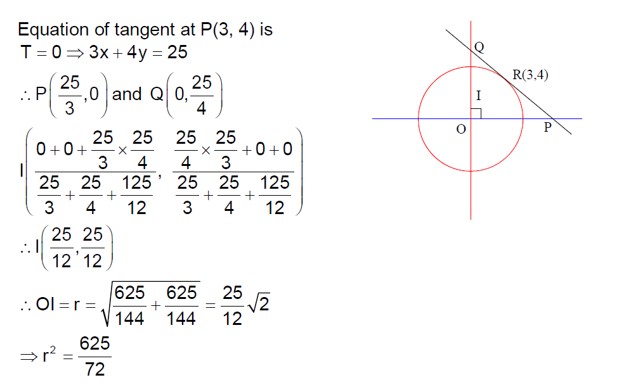Maths Applications of Derivatives
Get insights from 50 questions on Maths Applications of Derivatives, answered by students, alumni, and experts. You may also ask and answer any question you like about Maths Applications of Derivatives
Follow Ask QuestionQuestions
Discussions
Active Users
Followers
New answer posted
2 months agoContributor-Level 10
y = (3/2)sin (2θ)
x = e^θ sinθ
dy/dθ = 3cos (2θ)
dx/dθ = e^θ (cosθ + sinθ)
dy/dx = (3cos (2θ) / (e^θ (cosθ + sinθ) = (3 (cosθ - sinθ) / e^θ
New answer posted
2 months agoContributor-Level 10
y = x3
Equation of tangent y – t3 = 3t2 (x – t)
Let again meet the curve at
->t1 = -2t
Required ordinate =
New answer posted
2 months agoContributor-Level 10
f' (x)=g (x)
f" (x)=g' (x)
⇒g (x).g' (x)=f' (x).f" (x)
f (x) has five roots
⇒f' (x) has atleast 4 roots.
And f" (x) has atleast of 3 roots
⇒g (x).g' (x)=0 has atleast 7 roots in (a, b)
New answer posted
2 months agoContributor-Level 10
CD = √ (10+x²)² – (10–x²)² = 2√10|x|
Area
= 1/2 * CD * AB = 1/2 * 2√10|x| (20–2x²)
=> 10 – x² = 2x
3x² = 10
x = k
3k² = 10
New answer posted
2 months agoContributor-Level 10
Using Lagrange's Mean Value Theorem (LMVT) for x ∈ [−7, -1].
[f (-1) - f (-7)] / [-1 - (-7)] ≤ 2
[f (-1) - (-3)] / 6 ≤ 2
f (-1) + 3 ≤ 12
f (-1) ≤ 9
Using LMVT for x ∈ [−7, 0].
[f (0) - f (-7)] / [0 - (-7)] ≤ 2
[f (0) - (-3)] / 7 ≤ 2
f (0) + 3 ≤ 14
f (0) ≤ 11
Therefore, f (0) + f (-1) ≤ 11 + 9 = 20.
New answer posted
2 months agoContributor-Level 9
f (x) = (4a - 3) (x + ln5) + 2 (a - 7)cot (x/2)sin² (x/2)
= (4a - 3) (x + ln5) + (a - 7)sin (x)
f' (x) = (4a - 3) + (a - 7)cos (x)
For critical points f' (x) = 0
cos (x) = - (4a - 3) / (a - 7) = (3 - 4a) / (a - 7)
⇒ -1 ≤ (3 - 4a) / (a - 7) ≤ 1
Solving this inequality leads to:
⇒ a ∈ [4/3, 2]
New answer posted
2 months agoContributor-Level 10
P' (x) = a (x-1) (x+1) = a (x²-1).
P (x) = ∫ P' (x) dx = a (x³/3 - x) + b.
Given P (-3) = 0 ⇒ a (-9+3) + b = 0 ⇒ b = 6a.
Given ∫ P (x)dx = 18. Assuming the integration is over a symmetric interval like [-c, c] and using the fact that a (x³/3-x) is an odd function, ∫ (a (x³/3 - x)dx = 0. Then ∫ b dx = 18. If the interval is [-1, 1], this would be b (1 - (-1) = 2b = 18, so b=9.
With b=9, we find a = b/6 = 9/6 = 3/2.
So, P (x) = 3/2 (x³/3 - x) + 9 = x³/2 - 3x/2 + 9.
The sum of all coefficients is 1/2 - 3/2 + 9 = -1 + 9 = 8.
New answer posted
2 months agoContributor-Level 10
Let X1, ., X2n be the first 2n observations and Y1, ., Yn be the last n observations.
Given:
ΣXi / 2n = 6 => ΣXi = 12n (i)
ΣYi / n = 3 => ΣYi = 3n (ii)
Combined mean: (ΣXi + ΣYi) / 3n = 5 => ΣXi + ΣYi = 15n. This is consistent with (i) and (ii).
Combined variance: (ΣXi^2 + ΣYi^2) / 3n - (mean)^2 = 4
(ΣXi^2 + ΣYi^2) / 3n - 5^2 = 4
ΣXi^2 + ΣYi^2 = (4 + 25) * 3n = 87n.
New observations are Xi + 1 and Yi - 1.
New mean = (Σ (Xi + 1) + Σ (Yi - 1) / 3n = (ΣXi + 2n + ΣYi - n) / 3n = (15n + n) / 3n = 16n / 3n = 16/3.
New variance k:
k = (Σ (Xi + 1)^2 + Σ (Yi - 1)^2) / 3n - (new mean)^2
k = (Σ (Xi^2 + 2Xi + 1) + Σ (Yi^2 - 2Yi + 1) / 3
Taking an Exam? Selecting a College?
Get authentic answers from experts, students and alumni that you won't find anywhere else
Sign Up on ShikshaOn Shiksha, get access to
- 65k Colleges
- 1.2k Exams
- 679k Reviews
- 1800k Answers

